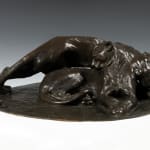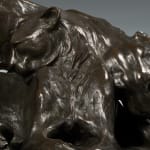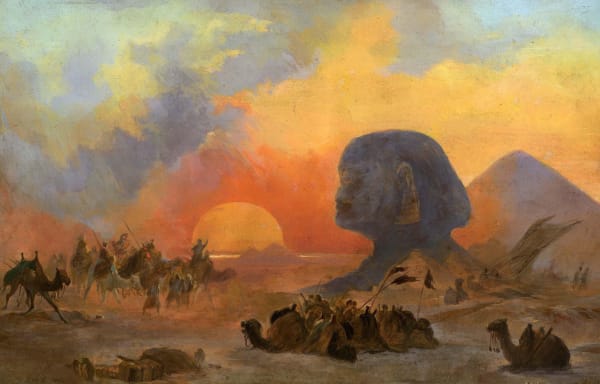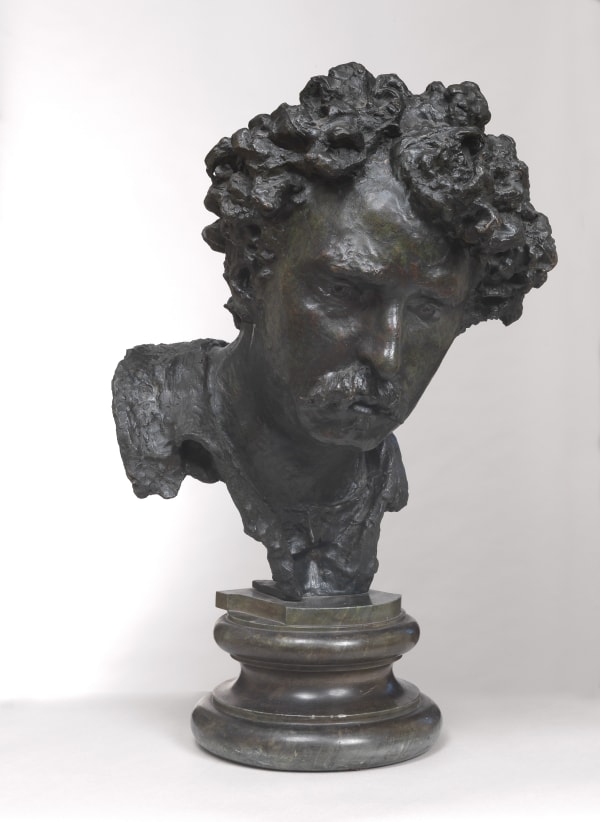

SIRIO TOFANARI FLORENCE 1886-MILAN 1969
SOLD
Provenance
Licurgo Bertelli, Florence; private collection, Florence
Literature
VIII esposizione Internazionale d’Arte della città di Venezia, exhibition catalogue, Venezia Premiate officine Grafiche C. Ferrari 1909, p. 39 room 5 n. 34;
S.a., VI Exposicion Internacional de Arte, in “Museum”, Revista mensual de arte Español antiguo y moderno y de la vida artistica contemporanea, vol. 1, n. 5, Establecimento Grafico Thomas, Barcelona 1911, pp. 167 – 210, in part. p. 196;
Marjorie Charles Driscoll, The M. H. de Young Memorial Museum Golden Gate Park, San Francisco California, Publisched under the auspices of the Park Commission, 1921, p. 26 e 79-80;
Terza Biennale Romana, international exhibition catalogue of Belle Arti, art publishing house Enzo Pinci, Rome 1925, p. 60, n. 9
Catàlogo del Museo de Arte Contemporaneo, Artes Graficas, Barcelona 1926, p.182, n. 30;
Sirio Tofanari Sculptures d’animaux, E. Ariani, Florence 1928, p. 8
Francesco Sapori, Scultura Italiana Moderna, La Libreria dello Stato, Rome, 1949, p. 37;
Adele Marchitelli, Sirio Tofanari, in Luci sul Novecento, Il centenario della Galleria d’arte moderna di Palazzo Pitti 1914-2014, curated by Simonella Condemi and Ettore Spalletti, Florence, Palazzo Pitti, Galleria d’arte moderna, 28 October 2014 – 8 March 2015, Sillabe publisher, Florence 2014, n. 14 (ripr.)
In this splendid bronze group depicting a young lion and lioness engaged in amorous play, Tofanari succeeds in conveying a feeling of strength and relaxation at one and the same time. Having built up extensive expertise in the animal world after exploring it in every aspect and at great length while in London, where he would spend long hours at London Zoo and at the Natural History Museum, the artist has succeeded in capturing a fleeting instant and in fixing it for eternity. Penetrating the very nature of the two animals portrayed with their eyes barely open in a typical expression of feline indolence, Tofanari steers clear at once of stylised abstraction and of excessively anecdotic treatment in his handling of the subject. He is attracted above all by the play of sinuous lines formed by the beasts’ two bodies as they languidly lean on one another, and that create a play of light and shade on the material (to which he imparts an alternate finish: now rough, now polished), its softness enhanced by the lost wax, or cire perdue, casting technique.
The sculpture was purchased directly from the artist’s workshop by his friend Licurgo Bertelli, a chemist and celebrated author of the Hoepli manual Cementi e calci idrauliche: fabricazione, proprietà, applicazioni published in 1912. According to a family memory handed down to his great-grandchildren, Tofanari destroyed the mould on completing the sculpture. Later on, when called on to show his work at the 8th Venice Biennale, he decided to mould a second copy and asked Bertelli to lend him the statue so that he could use it to produce the mould, but Bertelli refused.
Thus this bronze would appear to be an earlier work than the version of the Caress produced in 1909 along with the Young Lionesses for the fifth room in the Eighth International Art Exhibition of the City of Venice1, and purchased on that occasion for 750 lire by the Galleria d’Arte Moderna in the Pitti Palace in Florence, where it is still on display today2. It differs from that sculpture both in the colour of the patina and shape of the ovoid rather than square base, and in the handling of the underlying surface which in this case is rougher and more vibrant. Also, it bears the signature of the artist and the stamp of the prestigious Gusmano Vignali Artistic Foundry, which specialised in lost wax casting and which was to win a Grand Diploma of Honour at the International Exhibition in Dublin in 1907 and, a little while later, a Gold Medal at the Exposition Universelle in Brussels in 1910 3.
The successful start to Tofanari’s career at the 1909 Biennale caused him to consider the work a particular success and to want to show it again in Barcelona in 1911 at the VI Exposicion Internacional de Arte, where a Carícies won the gold medal and was purchased by the Museu Nacional d’Art de Catalunya4 whose catalogue, published in 1926, gives the statue’s height as 21 cm. A Caress was shown again in San Francisco in 1916 at the Golden Gate Memorial, M. H. de Young Museum5. We find a trace of this in the magazine ”American Art News”: “ … Mr. M. H. de Young has added also to his many other recent gifts to the Museum a series of original bronzes by Sirio Tofanari…”6. The event is confirmed also by the subsequent publication of the de Young Memorial Museum Golden Gate Park in San Francisco (1921), according to which Caress was on display in the Gallery of Statues along with other sculptural groups depicting animals – “splendid bronzes”7 – by the Florentine sculptor. The publication goes on to underscore Tofanari’s stylistic affinity with French sculptor Antoine-Louis Barye (Paris 1796 – 1875), who was extremely well-known in America at the time for his animal works, although they are said to be: “somewhat heavier and rougher in their modeling”8.
In the de Young Museum Caress was showcased alongside Leopard, portraying a feline while hunting, Tigers Fighting and a Lioness and her Cubs, in addition to a group of camels that attracted particular praise for Tofanari’s depiction of the “moment of demonstration when one of the animals, standing, has dropped his swaying neck to place his head cheek to cheek with another camel”. According to Driscoll, The Caress is, more than all the others, “a notable group for its sense of deliberate, easy motion. A lioness lies at full length, head raised. Behind her moves the lion, rubbing his head slowly along her shoulder. The easy lift of the lion’s great neck and forequarter muscles, and the slow stretch of the extended hind leg, are vibrant with a sense of luxurious power”9.
On the sidelines of the statue’s history, we should also note that the comparison with Barye’s work was dismissed in the introduction to the exhibition held at the Galleria Pesaro in 1923, where we are told: “ … Tofanari’s style now shirks the analysis of every meticulous minutia of cold details calligraphically sculpted and of surfaces skilfully modelled and polished; more modestly [he] summarises them in a nervous, self-confident and powerfully dynamic style with great simplicity of line and surface. This summary simplicity, however, leaves his agile, muscular animals their full liveliness and manages, in some of his more successful forms, to translate in the sculpture that deep expression of free and wild beasts’ psychology that Kipling’s pen has given us his jungle books…”10.
Unanimously held by critics to be one of the sculptor’s most successful works, it is among the 21 sculptures exhibited in the Individual Exhibition of Sirio Tofanari (with the title Carezze), held as part of the Third International Art Biennale in Rome (11), and is named in Caress is discussed in Francesco Sapori’s book on Italian Sculpure, in which he calls Tofanari: “The prince of the animaliers… he too is all eyes for predators, for fish, for beasts wandering freely or mortally wounded by hunters. Size is of little consequence: his thumb dwells fruitfully on the proportions of the real and at the same time he makes full use of the smallest ball of clay or wax. The intense vitality of the modeller, closely approaching a prodigy, is followed by the precious aftermath of the chiseller and the damascener…”12.
1) VIII esposizione Internazionale d’Arte della città di Venezia, exhibition catalogue, Venezia Premiate officine Grafiche C. Ferrari 1909, p. 39
2) Adele Marchitelli, Sirio Tofanari, in Luci sul Novecento, Il centenario della Galleria d’arte moderna di Palazzo Pitti 1914-2014, curated by Simonella Condemi and Ettore Spalletti, Florence, Palazzo Pitti, Galleria d’arte moderna, 28 October 2014 – 8 March 2015, Sillabe publisher, Florence 2014, n. 14
3) Fonderia Artistica Gusmano Vignali, Premiata fonderia artistica in bronzo ed altri metalli. fusione di statue, gruppi, bassorilievi, riproduzioni di originali antichi, Florence, Gusmano Vignali & Co., s. d. (dopo il 1910)
4) VI Exposiciòn Internacional de Arte, catalogo oficial, Barcelona 1911, p. 157, n. 1401; see also: S.a., VI Exposicion Internacional de Arte, in “Museum”, Revista mensual de arte Español antiguo y moderno y de la vida artistica contemporanea, vol. 1, n. 5, Establecimento Grafico Thomas, Barcelona 1911, pp. 167 – 210, in part. p. 196; Catàlogo del Museo de Arte Contemporaneo, Artes Graficas, Barcelona 1926, p.182, n. 30; from this catalog we can see the measure of the height of the work which is equal to 21 cm;
5) The lack of photographic reproductions in the catalogs and magazines of the time makes it difficult to hypothesize on which redaction – whether that of Palazzo Pitti with a square base or that of Bertelli with an ovoid base – Tofanari realizes the groups of Barcelona and San Francisco. With the rounded base and with the dark patina another specimen is also known, which measures cm. 22 x 68 x 54, datable to the 1920s, bearing the stamp of the Tortolini founder of Florence, which has been auctioned in recent years(cfr.: Farsetti Arte, dipinti e sculture del XIX e XX century, auction catalogue 08/11/2008, lotto n. 757).
6) s. a., San Francisco, in “American Art News”, vol 14, n. 26, New York 1 April 1916
7) Marjorie Charles Driscoll, The M. H. de Young Memorial Museum Golden Gate Park, San Francisco California, Publisched under the auspices of the Park Commission, 1921, pp.79-80; the full text below “splendid bronzes that stand in the art galleries adjoining Statuary Hall are the animal groups, six by Sirio Tofanari and one by Vanetti. These are groups of the Barye type, although somewhat heavier and rougher in their modeling, the figures often blended with the supporting background. Particularly good in its sleek strength is the “Leopard,” which occupies the center of one of the smaller galleries, a bronze some three feet in length, showing the animal in the intensity of the hunt, the steel muscles drawn taut, ears laid back and lips pulled away from the teeth in a snarl. There are two groups of “Struggling Tigers,” one by Tofanari and one by Vanetti, portraying the tigers in the thick of combat, lithe bodies flung into the fight, every muscle tense. A larger group is “Lioness and Cubs,” the lioness stretched at ease and the cubs crowding to reach the mother. “The Caress” is a notable group for its sense of deliberate, easy motion. A lioness lies at full length*, head raised. Behind her moves the lion, rubbing his head slowly along her shoulder. The easy lift of the lion’s great neck and forequarter muscles, and the slow stretch of the extended hind leg, are vibrant with a sense of luxurious power. Few artists have used camels for any other purpose than to give the proper atmospheric touch to desert scenes, but Tofanari in his camel group has found a new interest in these ungainly beasts. Like “The Caress,” the camel group portrays a moment of demonstration when one of the animals, standing, has dropped his swaying neck to place his head cheek to cheek with another camel, lying on the ground. The roughmodeling of the figures is particularly successful in its suggestion of a camel’s shaggy hide…”.
8) Ibidem
9) Ibidem
10) Mostra indivisuale di Serafino Macchiati, Sirio Tofanari, Mario Sotgia, exhibition catalogue, Galleria Pesaro Milano, May 1923, p. 19
11) Mostra individuale di Sirio Tofanari, in Terza Biennale Romana, catalogo della mostra internazionale di Belle Arti, art publishing house Enzo Pinci, Rome 1925, p. 60, n.9
12) Francesco Sapori, Scultura Italiana Moderna, La Libreria dello Stato, Rome, 1949, p. 37.
- Giovanna De Feo
Join the mailing list
Subscribe to our newsletter to receive all the news about exhibitions, fairs and new acquisitions!




